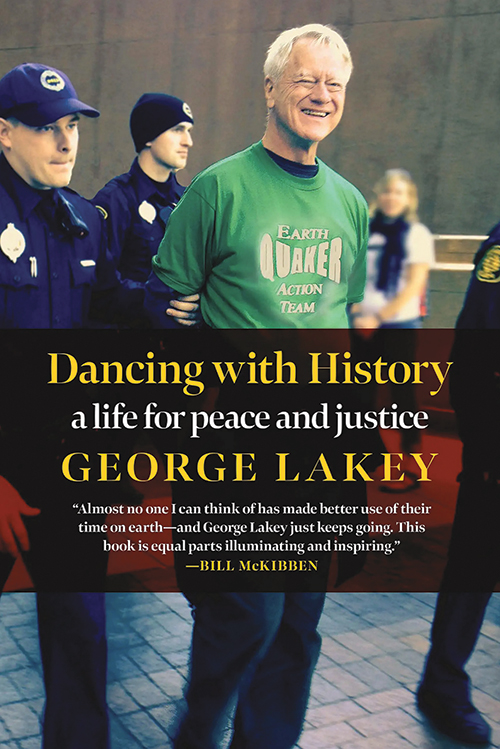
Dancing with History: A Life for Peace and Justice
Reviewed by Doug Gwyn
October 1, 2022
By George Lakey. Seven Stories Press, 2022. 424 pages. $22.95/paperback; $15.99/eBook (pre-order prices; available November 15).
George Lakey’s memoir is an important book for Friends and for the wide radius of activist groups his life of witness has influenced. It is a testament to the adage that the personal is political, and the political is personal. One can hear 80 years of U.S. culture pulsating through his body and spirit—not simply as unreflected zeitgeist but as spiritually discerned and focused by a resilient concern for actionable analysis and strategy for a more peaceful, just, and sustainable world.
Lakey credits his working-class origins in the Methodist church in eastern Pennsylvania for his orientation to practical methods and personal alliances for transformation. He carried his abiding love for Jesus into his Quaker convincement and into his many secular ventures in nonviolent work for change; his love for men; and his grounding in marriage and family with his Norwegian love, Berit Mathiesen. Time spent with Berit and her family in Norway long ago sowed the seeds for his 2016 book, Viking Economics: How the Scandinavians Got It Right—and How We Can, Too (reviewed in FJ Nov. 2016).
Lakey’s campaigns and projects are legion. Reading the book made me think of Leonard Cohen’s repeated refrain in his song “The Faith”: “O love, aren’t you tired yet?” The Movement for a New Society (MNS), founded in Philadelphia, Pa., in 1971 with George and Lillian Willoughby and others, is only the best known of the projects. MNS’s far-ranging influence among feminist, environmentalist, and anarchist action groups is noted in Andrew Cornell’s Oppose and Propose!: Lessons from Movement for a New Society (2011). More recent projects that Lakey has been involved in, such as helping to found Training for Change in the 1990s and Earth Quaker Action Team in the 2000s, may be more familiar to Friends today. But Lakey reaches back to credit the friendship and mentoring of earlier generations of Quaker activists such as Bayard Rustin, A.J. Muste, Larry Scott, and Charlie Walker, as well as James Farmer, director of the Congress of Racial Equality.
Lakey’s genius for strategy found early articulation in his booklet with Martin Oppenheimer, A Manual for Direct Action, hurried into print for use in training groups for the Mississippi Freedom Summer of 1964. More than half a century later, he distilled more experiential wisdom in How We Win: A Guide to Nonviolent Direct Action Campaigning (2018), including conversations with Daniel Hunter, Eileen Flanagan, and others. Occasionally Lakey gently suggests that many current movements would benefit from strategies based more in lived experience than named identities. He advocates intergenerational storytelling as a rich source of wisdom and nuance. This memoir is an ever-flowing stream of it.
If Lakey’s lodestar is the Light Within, and Central Philadelphia (Pa.) Meeting his ongoing faith community, his working-class origins are the nose with which he constantly sniffs the cultural affects around him. A pointed example in this memoir comes when he describes failing his oral examination for a PhD in sociology at the University of Pennsylvania in the mid-1960s, after excelling in coursework. The shock helped him realize that his gifts and aspirations weren’t aimed toward a more middle-class life in academia. He discerned that he needed to plow his academic training into continued social analysis, strategy, and grassroots action.
Somehow, Lakey sees himself as an introvert, which astonishes me as a shy, scholarly type. But perhaps all that organizing, friendship, and family life over all those years still left him more time for quiet reflection than the narrative suggests. Similarly, John Woolman’s Journal gives one the impression that he was always traveling in ministry. But I recall that someone reckoned that his travels averaged out to only about a month per year. Dancing with History also reminds me at times of another George—Fox’s Journal, which I have studied in depth over the years. Lakey’s personality is more appealing to most Friends today, but his genius is similar to Fox’s for probing into the nature of experience and turning it into creative conflict, actionable strategy, and resilient organization. Both have danced with history with abiding joy and conviction. I believe George Lakey’s memoir will take its rightful place among the classics of Quaker spiritual autobiography.
Doug Gwyn is a member of First Friends Meeting (also called Whitewater Meeting) in Richmond, Ind., part of the New Association of Friends. His books can be found at douglasgwyn.life, and his music at brothersdoug.me.
1 thought on “Dancing with History: A Life for Peace and Justice”
Leave a Reply
Comments on Friendsjournal.org may be used in the Forum of the print magazine and may be edited for length and clarity.



Wonderful revue! I can’t wait to read my dear F/friend’s book! 💙🌀🪬🌀💙